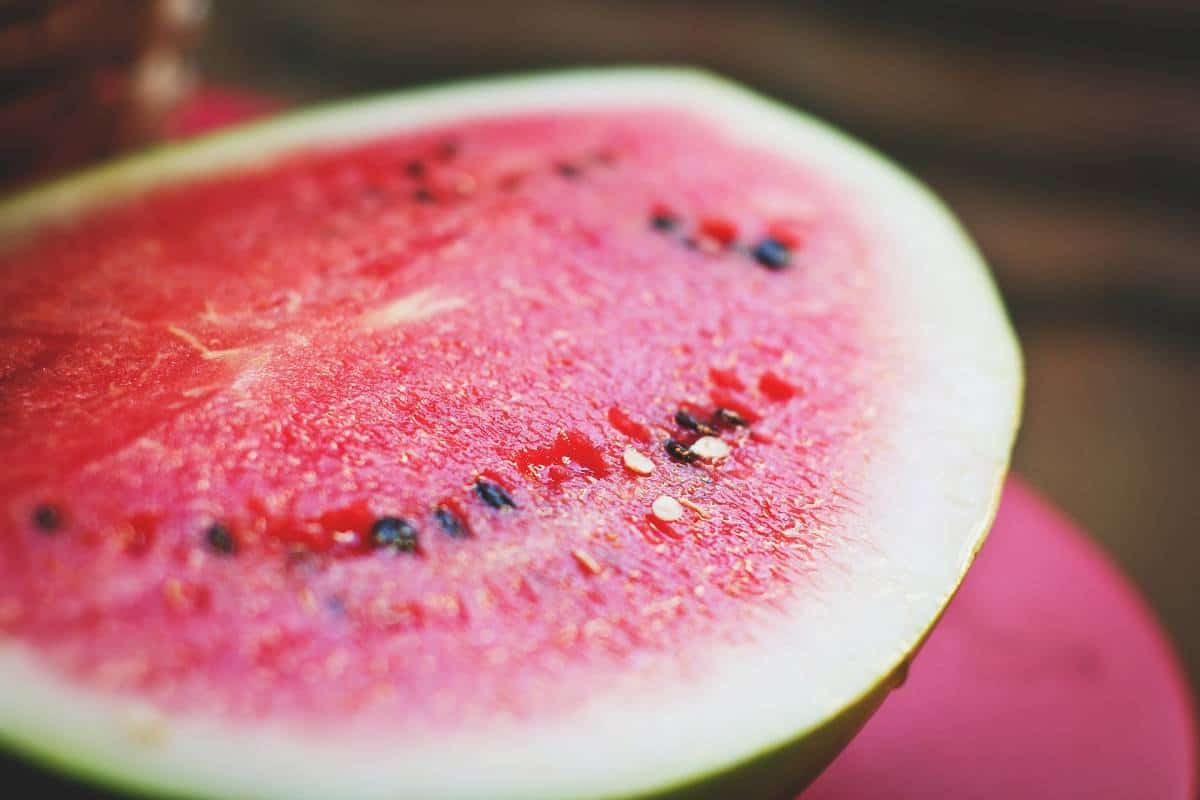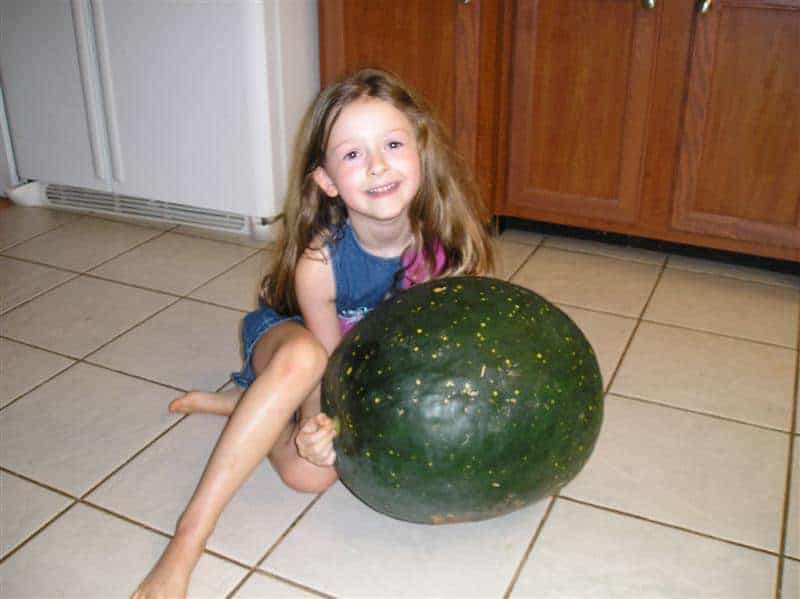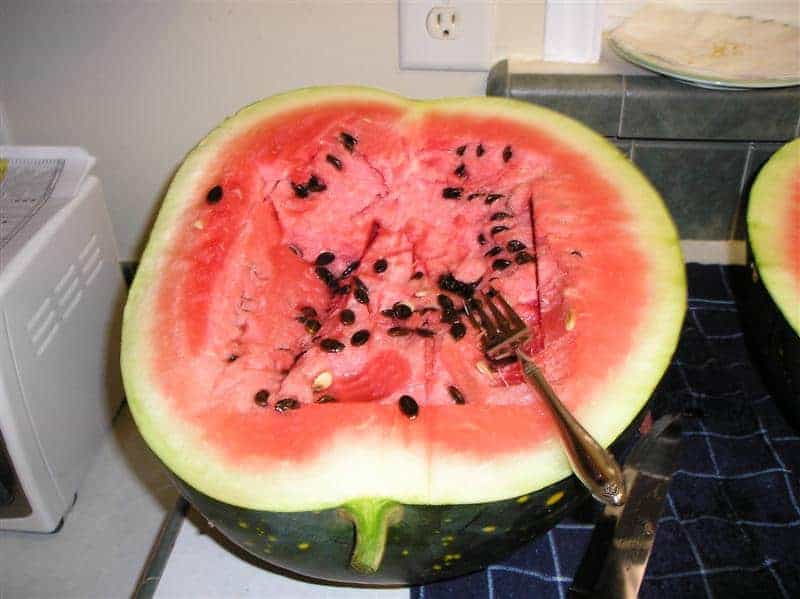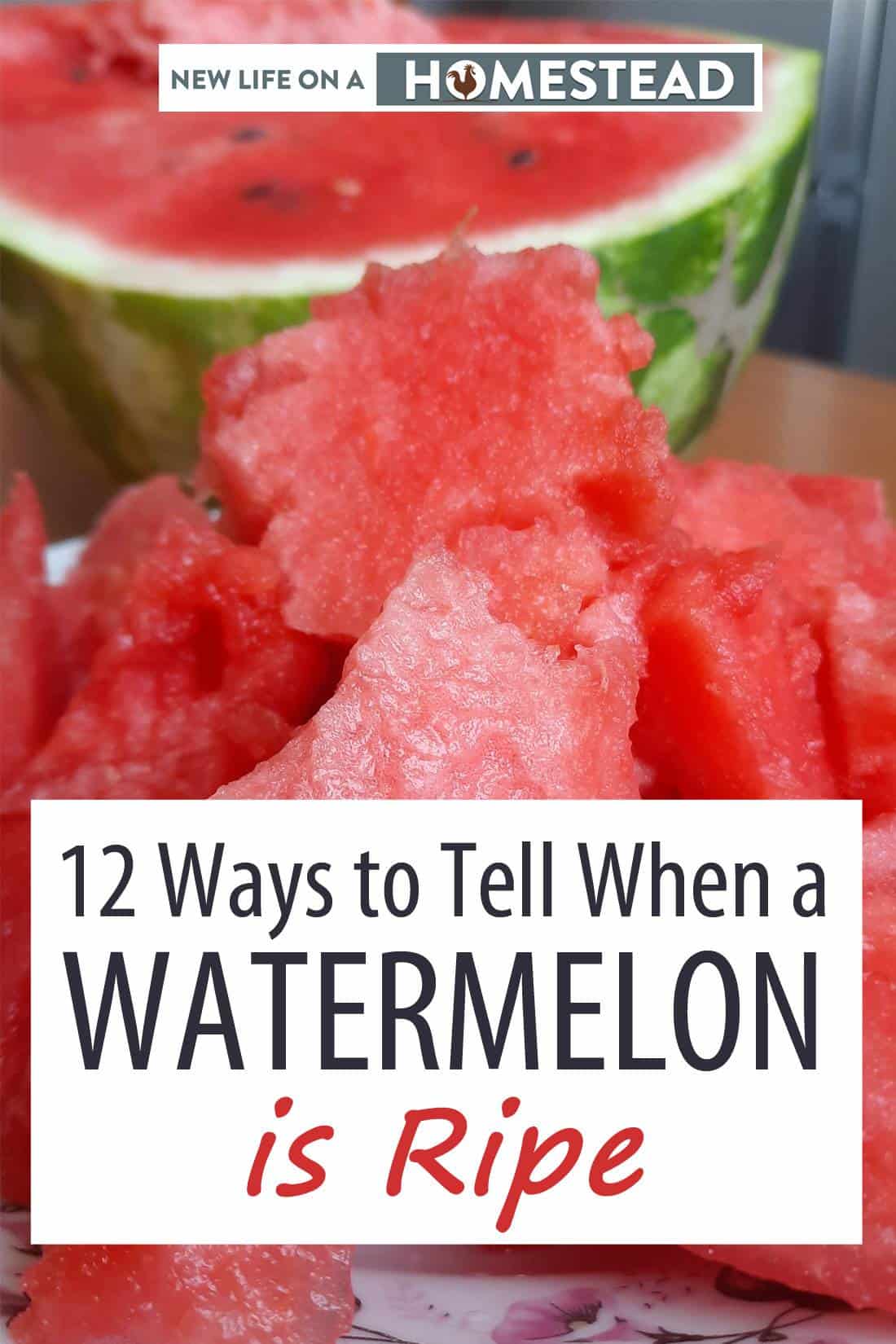I’m about ready to harvest my first watermelon! Not only my first watermelon of the season, but the first watermelon I have ever grown – ever! I’m incredibly excited to hit this milestone, as I’ve always had a hard time growing these delicious fruits.

In a few weeks, I think my fruit will be all ready to go.
You see, it’s not necessarily the growing of the watermelon that is challenging, but instead, knowing when it’s ripe. Unlike tomatoes and some other vegetables and fruits, watermelons won’t continue to ripen once you pluck them from the vine.
Therefore, it’s crucial that you know exactly when to harvest your fruit. Pick the watermelon too soon, and you can’t eat it – pick it too late, and it will be past its prime freshness.
It can be tough to know how to tell when a watermelon is ripe, but there are 12 signs that will tell you when it’s ripe.
1. Look for Dying Tendrils
If the tendrils on your watermelon plant are starting to dry, don’t panic! It’s not necessarily any cause for alarm, but instead a sign that your watermelon plant is heading past its prime.
The tendrils on a watermelon plant can actually give you a good idea of when your watermelon is good to go. When your melon is developing and is still quite small, the tendril will be pliable and green. However, as the fruit ripens, that tendril will lose its green hue, and turn brown.
As soon as your watermelon is fully ripe and ready to be harvested, you’ll notice that the tendril becomes dry and brown. Fully ripe fruit with brown tendrils can remain on the vine for about ten to fourteen days (as long as there’s not a lot of rainfall that can cause your watermelons to split open and rot).
You can follow this helpful rule of thumb for pretty much any kind of watermelon plant. The only exception to this is if you decide to grow a cultivar called ‘Sugar Baby,’ an icebox watermelon.
After he tenderly turns brown, you have to wait at least a week to pick it. Otherwise, it won’t be fully ripe.
2. Check Your Seed Packet
This is, by far, my least favorite method of determining when a watermelon is ripe. I don’t like the responsibility of having to go back to my seed packet to determine days to maturity – plus, it’s not always accurate, since the amount of time it takes for your watermelon to become mature can be affected by so many factors (like the weather).
However, in general, watermelons are ready to be harvested about 80 to 120 days after you planted your seeds. You can also pay attention to when the flowers on the plant open up. It usually takes around five weeks for a watermelon to go from flower to fruit.
In general, if you saved your seed packet, you can match your melon to the description on the seed package. As long as you’ve taken care of any watering, pest, or soil issues, your watermelon should be pretty close to the date of maturity and size listed on the seed packet (you may need to bust out the measuring tape, though!).
3. Check the Rind
As your watermelon is growing, it will have a waxy, shiny sheen. However, as your fruit ripens, that sheen will all but disappear, causing the rind to look rather dull in appearance.
Once you get skilled at growing watermelon, you’ll also notice that a ripe watermelon will stop feeling smooth and will instead feel kind of rough. If there are stripes on your watermelon, the contrast between the stripes will also become more pronounced.
4. Examine the “Ground Spot”
This sounds like a complicated technique but truly, it’s anything but. An easy way to tell if your watermelon is ripe is to look at the ground spot. The ground spot is simply the spot where the ripe watermelon rests on the ground. As your fruit develops, this spot will start out white but will gradually change color as your fruit ripens.
Typically, this ground spot will become yellow but on some fruits, it may look beige. There are some cultivars of watermelon – again, ‘Sugar Baby’ is another troublemaker – that develop brighter spots early on, before the melon is ripe. For these kinds of watermelons, you’ll have to rely on other clues to figure out if your fruits are ready for harvest.
5. Tap On It
One of the most tried-and-true methods of determining whether a watermelon is ripe is to tap on it.
All you need to do is hold the tip of your middle finger against your thumb and flick the melon. This will produce a sound regardless of how ripe your watermelon is.
However, if your melon is ripe, it will sound somewhat dull. If it’s more high-pitched, the melon needs to ripen more.
Personally, I am not very good at the thump test. I don’t think I have enough experience with growing watermelons to determine whether the sound is hollow or not.

6. Weigh It
A ripe melon will feel heavy. This is really hard to gauge, but most seed packets will give you an estimate to shoot for you. However, be aware that this is really only an estimate, as melons can be larger or smaller depending on the growing conditions.
Now, it’s important to note that you’re checking for the relative weight of the watermelon as compared to its size – not necessarily looking for the biggest watermelon. Size really doesn’t matter, but what does is that the watermelon feels heavy for its size.
7. Try to Pick It
Gently try to remove the watermelon in front of the vine. If it parts ways easily, it’s ripe. If you find yourself pulling with all of your strength, you may want to give it some more time. Usually, a gentle tug is all you need.
8. There’s An App For That
Like everything these days, there’s an app for that – even determining the ripeness of a watermelon!
To tell if your watermelons are ripe, you will want to use an option like Melony (if you have an Android) or iWatermelon Deluxe (if you have an iPhone). These apps are pretty advanced. All you have to do is place your phone or device on the watermelon and tap the melon three times.
The theory here is the same one behind the sound test I mentioned earlier in this article – however, the app takes the guesswork out of the equation for you. It will use sound analysis algorithms to figure out if your watermelon is ripe.
9. Sniff It
This one sounds a bit odd, but trust me, it works! Simply lift your watermelon and inhale deeply. If the melon is ripe, it will smell sweet – but not too sweet.
A melon with an overwhelmingly sweet aroma may be overripe. You can also use this method on other kinds of melon, like honeydew.
10. Squeeze the Melon
Squeeze the side of the melon (be gentle with this) to see if there’s any give. It shouldn’t be rock-hard, but it shouldn’t be soft, either (this can indicate an overripe watermelon).
An even better way to do this is to apply pressure to the blossom end of the watermelon. The blossom end is the part of the watermelon opposite the stem end.
If the melon is ripe, there will be a bit of give when you press here with your thumb. If it’s not, it will be hard. If the watermelon is overripe, it will offer you little resistance and will be a bit mealy.
11. Check the Connection Point
Look closely at where your watermelon hooks on to the vine. If you’ve ever grown pumpkins, squash, or other related plants, you know that the connection point will look a bit brown or cracked as it ripens.
This is true for watermelons, too, though not as quiet as easy to detect as in other vegetables and fruits.
12. Look for Webbing
Check for weblike brown spots on your watermelon. This means that bees touched the pollinating segments of the flowers multiple times. The more you see, the more likely the fruit was pollinated multiple times.
Now, this tip doesn’t necessarily indicate how ripe a watermelon is, but how sweet it can be. You also need to make sure you aren’t confusing spots with scars – insects can cause scars, as can mechanical damage and animals.
Mild scarring is usually not a big deal, but heavy scarring can lead to woody, tough areas inside the fruit (and it definitely won’t be sweeter).
How to Harvest Watermelon
You can harvest your watermelon once all of the signs mentioned above indicate that your fruits are ripe. These fruits mature the most readily when the weather is hot, with most ready to go about 32 days after blooming.
When you are ready to harvest, use a pair of clippers to cut the watermelon from the vine. Some people use their hands to pull and tug the fruit away, but I would prefer to lob it off with a pair of shears or clippers for several reasons.
Not only does this eliminate the need for me to grab on to the prickly vine (something that always leaves my fingers feeling prickly and uncomfortable afterward!) but it also prevents you from accidentally pulling the vine up and out of the ground.
If you have several fruits growing in the same plant or growing nearby, this is essential – you don’t want to pull up the plant if you still have several fruits that have yet to ripen.
Bring your watermelon inside and, if they are particularly dirty, wipe them down with a wet cloth and then dry thoroughly before putting them into storage.

Storing Watermelons After the Harvest
Once you’ve determined that your watermelons are ripe and ready to be harvested, there are a few other steps you’ll need to take to ensure that they stay good for eating.
Usually, you can store watermelon for 14 to 21 days after they have been harvested. The key here is storing them properly. Watermelon will continue to produce vital nutrients after they are picked, but only if you store them at the right temperatures.
Chiling watermelon causes them to decay more quickly. You should instead store your melons at around 55 degrees Fahrenheit (12 Celsius). A cool, dry basement is ideal for this.
Wrap Up
I’m looking forward to tasting the fruits of my labor – pun intended! – and now that I know how to tell when a watermelon is ripe, I feel confident that I’ll be able to time my harvest perfectly this fall.


Rebekah is a high-school English teacher n New York, where she lives on a 22 acre homestead. She raises and grows chickens, bees, and veggies such as zucchini (among other things).

Great. Would be better with more images (like of the tendrils and such)